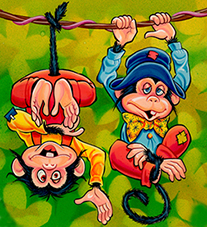Drawing Interest
A Cartoonist And Proud Of It
by Edward Letwenko
NCS Chicago Midwest Chapter Member since 2018
“It’s okay if you want to be an artist but you have to forget this cartoon stuff”.
— Advice from a family friend
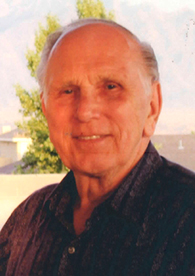 Hi, my name is Ed Letwenko and I am a Cartoonist. When meeting and talking with other cartoonists over the years I’ve come to believe most of us have been cartoonists forever. I think those of us that are still making cartoons have probably been drawing since we were 5 or 6 years old, maybe even earlier, and always having fun creating our own comics.
Hi, my name is Ed Letwenko and I am a Cartoonist. When meeting and talking with other cartoonists over the years I’ve come to believe most of us have been cartoonists forever. I think those of us that are still making cartoons have probably been drawing since we were 5 or 6 years old, maybe even earlier, and always having fun creating our own comics.
When I was that age my parents owned a grocery and meat market in Chicago. The large sheets of butcher paper stacked on the counter used to wrap meat from the chopping block became my Bristol board.
Most Saturday nights several sheets were laid out on the kitchen floor all criss-crossed with squares ready to become Sunday comic pages. Spread out on the floor with these sheets were the Sunday editions of Chicago’s newspapers (early editions were released on Saturday nights.)
Chicago had five daily and Sunday papers during my growing up years in the 1930’s and 40’s. The Chicago Tribune, Chicago Times, Chicago Herald American, The Chicago Daily News was an afternoon paper and did not print on Sunday, but released it’s comics with the Saturday edition. The new kid on the block around 1940s was The Chicago Sun, which eventually merged with the Times to become the Sun-Times.
Every one of these newspapers had a full color comic section of 6 to 8 pages. The comic strips in each paper were individual. The only duplication I remember is that one paper had the Katzenjammer Kids and another had The Captain and the Kids. Both strips contained the very same cast of characters.
These were my first self-elected drawing lessons. There it was in front of me. I could pick any style I wanted. Who did I want to draw like? I could copy Dick Tracy or Terry and the Pirates or Flash Gordon. Maybe I should pick a funnier style like Blondie and Dagwood, Barney Google. Maggie and Jiggs? Every Saturday night I was surrounded by a treasure trove of skill and imagination. To me it was magic and pure joy. When you are 7 or 8 and start showing your drawings to members of your family you’re told you are clever and talented. Friends of the family tell you how terrific your drawings are as they pat you on your back, or the top of your head. It makes you feel good even though they are probably lying. The only person who was really paying attention was my mother. When I was eleven years old she took me to the Kroch’s and Brentano’s bookstore in downtown Chicago. which had the largest selection of art books to be found anywhere in the city. I’ve never seen another like it. I spent a lot of time browsing and buying art books there in later years, but on that day my mother bought me my first how to draw book. I think I tried to copy every page in it. When I was 12, I sold my first gag cartoon to a publication called ”The Hobo News”. The “News” came out weekly, looked like a newspaper but contained only gag cartoons. Unfortunately, I only sold them the one, however that was enough to spur me on and keep drawing.
The next step after high school, I got a part time summer job as a copy boy for United Press news service, which was full of noisy typewriters and teletype machines as were shown in the movies. This same summer I started classes at the Chicago Academy of Fine Arts. CAFA was the only art and design school in Chicago that was teaching cartooning in those days A new world was opened for this sixteen-year-old. CAFA must have had a great reputation. The students enrolled in the school came from almost every state in the union. This was 1946 and I was also surrounded by G.I.s returning from world war II and studying under the G. I. bill.
I made a lot of friendships during the three school years, and many of them have continued through all these decades. One of my best friends was Ben. He wasn’t a cartoonist, but a real fine artist who wanted to go into advertising. When we were 6 months away from graduation the uppermost thought in our mind was to put together a super portfolio of our self perceived great art to find a big money job straight out of school.
Ben was a history buff and he also did some writing. The subject that fascinated me at that time was archeology. Now, doesn’t that just scream out, WOW what a perfect partnership for creating a new comic strip?
Well that’s exactly what it was. We came up with a new hero. Ben and I spent the next six months writing, rewriting, drawing and redrawing. By graduation time we drew 6 weeks of daily strips (two weeks inked and four weeks in pencil) plus four Sunday pages.

The name of our strip was MARTIN SANDS, ARCHEOLOGIST. A tall, handsome, rugged and intelligent guy who traveled the world seeking lost treasures and always bumping into dangerous adventures. (Huh! Who is this Indiana Jones?)
Earlier I stated that I worked at United Press news service. They owned United Features syndicate. The syndicates Chicago office was coupled with the news office. I knew most of the personnel in the newsroom and the syndicate and was able to get an appointment to show the strip. The meeting we had with the syndicate people went beyond anything Ben or I anticipated. They liked the concept of the strip and most of what we had already done. We spent several hours with them discussing the characters and the direction of the story line. (They also liked the artwork. Whew!) We were asked to make the changes that they suggested and bring the strip back in two weeks. Naturally we left the syndicate office flying high. Here we were two 20-year olds Just two weeks out of school and on the verge of selling an adventure strip to a syndicate. Unfortunately—— the high only lasted for a week. The Korean War began and Ben was Drafted into the Army. I was never called up because I have scoliosis. There went our quick fame and fortune. Ben was sent to Germany instead of Korea and became an aerial photographer. He came home three years later.
We thought about reviving Martin Sands but picking up pieces from the past doesn’t always work. It was the middle 50s the comics business was changing. The comics were losing space in many papers, adventure strips were being dropped and any replacements were usually humorous and simply drawn. Most of all each of our interests had changed so we decided to let Martin Sands rest in peace and just dream of what might have been as we both pursued new art careers. My wife and I were married in July of 1956 and in the same month I began working at Koopman –Neumer studio in Chicago. The studio used two floors of space one floor for art and the other for photography. I was assigned a drawing board in a back corner of the room next to a window. From this position I could see the whole room. It was very large and full of drawing boards like the one I had. The boards were grouped in sections. I had been put in with the layout artists. The section in front of them had the Illustrators and any other finished art, next were the guys that drew very fancy hand lettering. Another large group was the photo retouchers whom I watched cut a frisket mask on a photo without so much as a nick on its surface. The largest of the groups were the paste-up people. They did the page assembly. In those days every piece of art, photograph or block of type was cut out and pasted into position by hand. The paste–up had to match the detailed measurements of a layout. If the page was off by a 1/16 of an inch it had to be redone.
 I wasn’t given assignments for my entire first week on this job. Whenever I approached the Art Director asking for work he would just tell me, “I’ll get to you”. This gave me plenty of time to introduce myself to most of the artists and be able to watch them work. One of the studio’s largest accounts was the Curtis candy Company. The originators and manufacturers of Baby Ruth and Butterfinger candy bars. They were also sponsoring a television series titled “Tales of the Texas Rangers”.
I wasn’t given assignments for my entire first week on this job. Whenever I approached the Art Director asking for work he would just tell me, “I’ll get to you”. This gave me plenty of time to introduce myself to most of the artists and be able to watch them work. One of the studio’s largest accounts was the Curtis candy Company. The originators and manufacturers of Baby Ruth and Butterfinger candy bars. They were also sponsoring a television series titled “Tales of the Texas Rangers”.
Tuesday morning and no assignment came my way, but I was now aware of some of the accounts being worked on. I decided to spend my time working on layouts for the candies and some of the other accounts too. I also came to notice I was the only cartoonist in the studio. By the time the work week ended on Friday, I filled four 20×24 layout pads ad layouts and sketches.
The following Monday morning as I was getting settled at my board, I looked up and standing directly in front of it was a man about 6’4” and the bearing of a Prussian General. He was slim, with grey hair that was slicked back. His arms were folded across his chest. He looked down and said “You’ve been here for a week. What have you done”? I explained that I was not assigned any work all week. “What did you do with your time all week”? He asked. reached down under my board and pulled out the four layout pads. I spent the week sketching ad ideas and layouts for a variety of accounts”. “Give them to me” he said, as he took them out of my hands and walked away.
The rest of the morning went by the same as the previous mornings and I went to lunch feeling a little nervous. When I returned from lunch the A D. called me in to his office. I went in thinking he was going to fire me, instead he had good news for me. He told me that Mr. Koopman liked my layouts. He showed them to the people at Curtis candy that morning and they bought two of them to appear in Colliers magazine. Colliers prestige and reputation was almost equal to the Saturday Evening Post). I did the finished cartoon art for both ads.
From then on assignments for varied accounts became the norm and I managed to incorporate cartoons in many of the magazine ads. I also became Mr. Koopman’s go to guy for varied “special projects”, and he had many of them, one of which was designing corporate Christmas cards for several of the clients. Once again I thought, man I’m on my way. (Oh Yeah?)
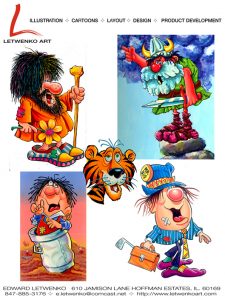 Koopman- Neumer was one of the few studios in Chicago that had an artists union at that time. I was told I must Join the union within a year or leave the job. I never was able to make a choice. Eight months into my year the union called a strike. When I showed up for work the first day on strike, a couple of men with large brimmed fedora hats, heavy overcoats and bent noses were blocking the front door. I was told I couldn’t go in because of the strike, and I had the choice of carrying a picket sign or going home. I chose to go home. The A. D. called and asked me to cross the picket line. Union busting was not something that interested me. I refused and I knew it meant that when the strike was over I wouldn’t be invited to return.
Koopman- Neumer was one of the few studios in Chicago that had an artists union at that time. I was told I must Join the union within a year or leave the job. I never was able to make a choice. Eight months into my year the union called a strike. When I showed up for work the first day on strike, a couple of men with large brimmed fedora hats, heavy overcoats and bent noses were blocking the front door. I was told I couldn’t go in because of the strike, and I had the choice of carrying a picket sign or going home. I chose to go home. The A. D. called and asked me to cross the picket line. Union busting was not something that interested me. I refused and I knew it meant that when the strike was over I wouldn’t be invited to return.
The studio outsourced its work and I got a job at one of the small studios that they used. Everything went well, but six months later the strike ended and so did the work from Koopman- Neumer. The small studio didn’t survive without the extra work and folded. I was out of a job again and back pounding the pavements to show my portfolio. At the same time my wife Bobbie was no longer working because she was pregnant with our first child, our daughter, Kate.
Lady luck had a different plan for me this time. After weeks of appointments and interviews I did not get a job in any art studio. There was a small recession going on, I was often told.
Our meager savings were dwindling. I had to find a way to bring in some money, working at whatever job I could find. That turned out to be driving a truck on a prescribed route as a laundry man on the North side streets of Chicago.
I quickly discovered I did not want to make a career of this line of work. Each day began at 5:30 AM, loading a Van with finished laundry and dry cleaning to be delivered that day. You had to be on the road by 6 am. Every route was in a specific area of the city and you had route tickets to guide you. Once you reached your territory the rest of the day was spent running up and down three or four stories of back porch stairs carrying bundles of laundry and hangers of dry cleaning, stopping long enough to collect the money.
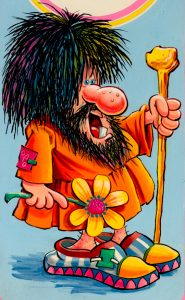 The job itself paid well, but being a successful cartoonist was still my main goal. I needed to find time in which to make appointments at studios and agencies to keep showing my portfolio, so I formed a plan.
The job itself paid well, but being a successful cartoonist was still my main goal. I needed to find time in which to make appointments at studios and agencies to keep showing my portfolio, so I formed a plan.
The plan I developed was rather devious, but it worked. It worked so well I began to think it was hatched by destiny or perhaps a real terrific guardian angel who was pulling all the strings to make it work. Let me explain.
The first step was to reshape my route. Within two months I managed to have almost all of my customers agree to pick-ups and deliveries before noon. (Learning to sell was a side perk.) My route was finished by noon time 4 out of 6 days a week. My afternoons were free to make calls. Trucks were not expected to return to the garage until 4 pm. All drivers were expected to go door to door selling our services. I fulfilled my company obligations in between calls and found a minimum of three new customers a week as was required.
The next challenge was what to do with truck. The company had spotters driving through the routes making sure we were all doing our jobs, so I couldn’t leave the truck on the street or in a parking lot. I searched around and found an alley shaped like a dog leg, there was no way to see through the entire alley from either side of the block. The dog leg part was in back of a closed factory that had parking spaces in the rear. I’d park the truck there and no one could see it. Around the corner was a restaurant that had a large bathroom in the basement where I could clean up and shave again if I chose to.
Bizarre as all this planning seemed, I was ready to begin. Every morning after I Loaded my truck an left the garage I pulled by my car, pulled my portfolio from the trunk And hid it under the bags and bundles of laundry, Then I hung my suit, tie and fresh shirt on the rod with the dry cleaning I had to deliver.
After 9:AM I would make phone calls in between stops from gas stations and coffee shops to ad agencies and studios. In those years it was not difficult to get a face to face meeting with Art Director or buyer. When I made an appointment, I would change clothes, hide the truck and take a streetcar to Michigan Ave. When I returned, I reversed the process, changed into my uniform and became a laundry man again.
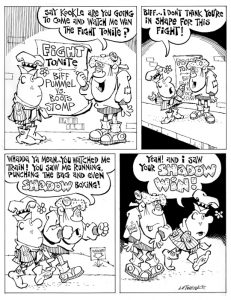 Free lance work was easier to get than a full-time job, and whether it was luck or my guardian came through again in a few weeks work started coming my way. Deadline time from agencies was usually, and probably still is, short. Many times I had to deliver finished art the next day. The freelance business really began to build. I was working both jobs. Days on the truck and several nights and lots weekends on art.
Free lance work was easier to get than a full-time job, and whether it was luck or my guardian came through again in a few weeks work started coming my way. Deadline time from agencies was usually, and probably still is, short. Many times I had to deliver finished art the next day. The freelance business really began to build. I was working both jobs. Days on the truck and several nights and lots weekends on art.
My wife and I were living in a two-bedroom flat on Fullerton St. and Cicero Ave. in Chicago. In October of 1957 Our daughter Kate was born and the bedroom I was using as a studio became a nursery, so after dinner and the dishes were washed the kitchen table became my workplace. Our second floor flat had an enclosed porch which became my studio in the summertime.
There were many very busy large sized printing companies in Chicago during the 1950s that also used free lance artists. Many of them printed newsletters or teaching materials. They used layout artists, illustrators and even cartoonists. I got a couple of newsletters I could count on every month. One day when I was delivering some art the printer suggested I call a new customer of theirs who was looking for a cartoonist. I met with a man named Bob. He started a new company that created Greeting cards. Only humorous greeting cards.
In the late 1950s new style of greeting cards surfaced in California. They were called studio cards. So named because they were just line drawings of humorous characters and hand lettered captions. They all had the look of being original sketches from an artist’s studio.
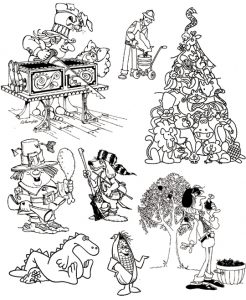 Bob supplied the captions and I was to draw what I thought fit the sentiment. The first assignment was for four cards @ $20.00 each C. O. D. He was pleased with Wha
Bob supplied the captions and I was to draw what I thought fit the sentiment. The first assignment was for four cards @ $20.00 each C. O. D. He was pleased with Wha
t I did and four cards a week became a regular gig. Bob was happy. I was happy and the printer was happy. My other accounts were picking up too. I started this double life game in the fall of 1957, I met Bob in the summer of 1958. All of this kept on through the fall of 1959. Our son Michael was born in October of that year. Now our two bedroom flat felt very small. Working in the kitchen through the wee hours with two children in the next room wasn’t comfortable. Working on the back porch through the fall and winter couldn’t work because it was not heated. We would have to move, or I needed to rent studio space. Between Bob, the other freelance I was making enough to think about leaving the laundry route. Decisions, decisions, what should I do?
This is where I think my super guardian angel got involved. When I told Bob what I needed he made me a surprising offer. He had extra office space he would let me use rent free plus the use of the phone. The only commitment from me was that I would give his work top priority.
When I came to set myself up in the office, I found that Bob had two other free lance cartoonists working there. The Office had a large bulletin board on the wall with card ideas push pinned in it. We were told to choose any caption we wanted and turn them into greeting cards. To make a good impression for my first free week I created eight greeting cards in two days.
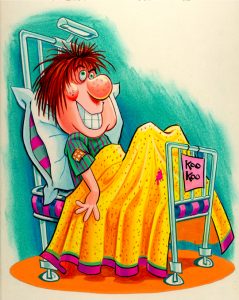 Bob always paid on Fridays and gave me a check for $160.00. The two others only drew one card a piece and were paid $20.00 each. They complained about the difference the payments because they spent as much time in the office as I did. When he pointed out that it’s payment by the card they both got angry and quit.
Bob always paid on Fridays and gave me a check for $160.00. The two others only drew one card a piece and were paid $20.00 each. They complained about the difference the payments because they spent as much time in the office as I did. When he pointed out that it’s payment by the card they both got angry and quit.
I was now the only cartoonist he had. He did not bring in anyone else, he just kept me busier and busier between that October and December, then a few days before Christmas Bob made me an offer of a full-time position I didn’t want to refuse. I went Home that evening and my wife Bobbie and I discussed the pros and cons of the offer.
We decided I should take a chance and say yes. That December was the beginning of a business relationship that lasted twenty years.
The adventures and glitches, good or bad in the corporate world of the growing United Card Company for twenty years, becoming its creative director and print manager, then having my own business for another thirty, I’ll leave to write about for another time.
You may have noticed there are a lot of “I did’s” in this writing. The truth is I did not reach my goals or make accomplishments without several mentors and people who believed in me and had my back along the way.
The biggest fan I had when I started and still have now is my wife Roberta (Bobbie). The decisions regarding our futures was and is made together, and times when because of my stubbornness or ego the decision was wrong, she still had my back. Bobbie has done that for more than 64 years. My guardian angel knew what he was doing when he let me find her.
I’m writing this at the age of 88. I’m still drawing and still love it as much as I did when making comics on butcher paper all those years ago.
HAPPY CARTOONING, ED
